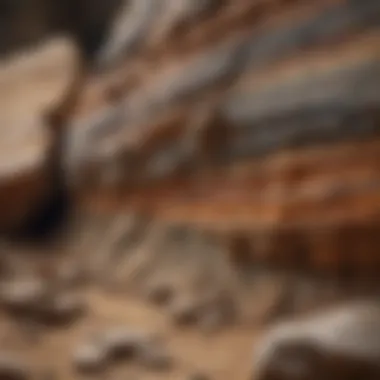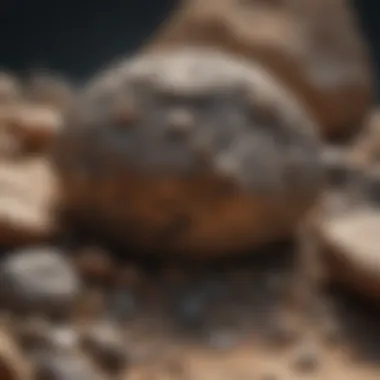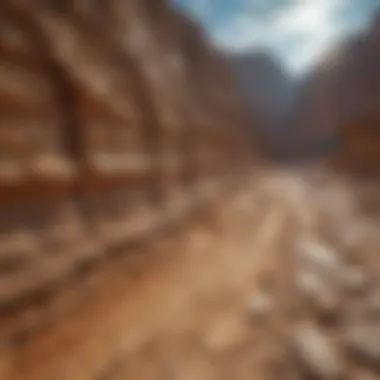Exploring the Fascinating World of Rock Formation: A Detailed Guide for Enthusiasts


Rock and Fossil Identification
When delving into the enthralling realm of rocks and fossils, understanding the various types and their distinguishing characteristics is paramount for enthusiasts. Sedimentary, igneous, and metamorphic rocks each possess unique attributes that aid in their identification. Sedimentary rocks, such as sandstone or limestone, are formed through the accumulation of sediments over time. Igneous rocks, like granite and basalt, originate from the cooling and solidification of molten rock. Metamorphic rocks, including marble and slate, undergo changes due to intense heat and pressure.
Exploring further, keen observers must pay close attention to specific characteristics when identifying rocks and fossils. Texture, color, mineral composition, and structural features all play a pivotal role in differentiation. Surface patterns, crystal formations, and fossil imprints are telltale signs that assist enthusiasts in categorizing the specimens they encounter. By honing in on these key attributes, individuals can better appreciate the diversity and complexity of rock formations.
Aiding in this identification process, utilizing specialized tools proves instrumental for rock and fossil enthusiasts. Items such as rock hammers, magnifying glasses, chisels, and brushes enable collectors to examine specimens closely and extract them from their surroundings with care and precision. The proper use of these tools enhances the overall experience of identifying rocks and fossils, elevating it from a hobby to a systematic and rewarding pursuit.
Introduction
This article serves as a comprehensive guide for individuals interested in identifying various types of rocks. Rock enthusiasts, whether beginners or experienced collectors, will benefit from the detailed insights and techniques provided here. By exploring sedimentary, metamorphic, and igneous rocks, readers will gain a deeper understanding of the distinct characteristics that define each rock type.
Overview of Rock Classification
Understanding the Rock Cycle
The Rock Cycle is a fundamental concept in geological science that portrays the continuous processes through which rocks are formed, transformed, and recycled on Earth. Understanding this cycle is pivotal for enthusiasts as it outlines the dynamic interplay of processes like erosion, sedimentation, heat, and pressure that shape rocks over time. By grasping the Rock Cycle, individuals can appreciate the cyclical nature of rock formation, leading to a more profound appreciation of Earth's geological history.
Importance of Rock Identification
Rock identification is a crucial skill that allows enthusiasts to decipher the characteristics of different rocks and unveil their geological significance. By mastering rock identification, collectors can classify rocks based on key attributes like mineral composition, texture, and color. This skill empowers enthusiasts to not only recognize rocks in their collection but also understand the environmental conditions that contributed to their formation. Consequently, rock identification enhances one's ability to interpret the geological processes that have shaped Earth's surface throughout history.
Sedimentary Rocks
Sedimentary rocks play a crucial role in our understanding of rock formations, offering a glimpse into the earth's history through layers of sediment. Their significance lies in providing valuable insights into past environments and processes. By examining sedimentary rocks, rock and fossil enthusiasts can unravel geological mysteries and decipher clues about ancient climates and habitats.
Features of Sedimentary Rocks
Grain Size and Composition
Grain size and composition are fundamental characteristics of sedimentary rocks that reflect the depositional environment and the history of the rock. The size of the grains, whether fine, medium, or coarse, provides clues about the energy of the environment in which the rock was formed. Additionally, the composition of the grains, such as quartz, feldspar, or clay minerals, offers insights into the source rock and the geological processes involved. Understanding grain size and composition is essential for interpreting the origin and depositional setting of a sedimentary rock.
Layering and Bedding


Layering and bedding in sedimentary rocks are visible stratifications that result from the sequential deposition of sediments over time. These features provide valuable information about the depositional conditions, including the direction of sediment transport, changes in sediment supply, and variations in environmental conditions. The distinct layers in sedimentary rocks indicate different episodes of sedimentation, allowing geologists to reconstruct the geological history of an area. By studying layering and bedding, enthusiasts can uncover the dynamic processes that shaped the Earth's surface.
Common Types of Sedimentary Rocks
Sandstone
Sandstone is a prevalent sedimentary rock known for its coarse-grained texture (continue the content for Sandstone with detailed descriptions, characteristics, and significance)
Shale
Shale, a fine-grained sedimentary rock composed of clay minerals, silt, and organic matter, plays a vital role in (elaborate on the unique features, benefits, and uses of Shale in the context of this guide)
Limestone
Limestone, a carbonate rock primarily made of calcite or aragonite minerals, is a versatile sedimentary rock revered for (provide detailed information on the properties, uses, and importance of Limestone in rock and fossil identification)
Metamorphic Rocks
Metamorphic rocks are a fundamental aspect of this comprehensive guide, providing valuable insights into the transformational processes rocks undergo. Understanding metamorphic rocks is crucial for rock and fossil enthusiasts as it sheds light on the profound changes that occur beneath the Earth's surface. By delving into the intricacies of metamorphic rocks, individuals can grasp the dynamic nature of Earth's geology and the forces that shape rock formations over time.
Characteristics of Metamorphic Rocks
Foliation
Foliation, a defining characteristic of metamorphic rocks, plays a significant role in the overall texture and structure of these rocks. It refers to the parallel alignment of minerals within the rock, creating a layered appearance. This alignment results from the intense pressure and heat that metamorphic rocks undergo during their formation. Foliation not only contributes to the remarkable visual appeal of metamorphic rocks but also provides geologists with valuable information about the rock's history and the conditions under which it was formed.
Index Minerals
Index minerals are another crucial aspect of metamorphic rocks, serving as indicators of the pressure and temperature conditions under which the rocks were metamorphosed. These specific minerals form only under certain temperature and pressure ranges, allowing geologists to determine the metamorphic grade or intensity of metamorphism a rock has experienced. The presence of index minerals provides valuable clues about the geological processes that have shaped the rock, aiding researchers in reconstructing Earth's complex history.
Examples of Metamorphic Rocks
Marble


Marble, a type of metamorphic rock prized for its beauty and versatility, is formed from the metamorphism of limestone. Its distinctive veining and range of colors make it a popular choice for various construction and artistic applications. With its excellent polish retention and durability, marble has been favored for centuries for sculptures, flooring, and architectural elements.
Slate
Slate, known for its fine-grained texture and exceptional durability, is a metamorphic rock derived from shale or mudstone. Its excellent cleavage properties allow it to be easily split into thin sheets, making it a preferred material for roofing, flooring, and decorative purposes. Slate's characteristic smooth surface and resistance to environmental factors have made it a timeless choice for diverse architectural projects.
Quartzite
Quartzite, a high-quality metamorphic rock formed from sandstone, showcases outstanding hardness and resistance to abrasion. Its distinct granular texture and vibrant colors make it a sought-after material for countertops, wall cladding, and decorative purposes. With its exceptional durability and unique aesthetic appeal, quartzite stands out as a top choice for both residential and commercial applications.
Igneous Rocks
In the realm of rock classification, Igneous Rocks stand out as a crucial topic that demands in-depth exploration. Understanding Igneous Rocks is essential for rock and fossil enthusiasts as they offer insights into the Earth's fiery origins and geological processes. By delving into the properties and varieties of Igneous Rocks, enthusiasts can unravel the intricate formations and compositions that shape our planet's landscape.
Properties of Igneous Rocks
Texture:
Texture plays a pivotal role in discerning the characteristics of Igneous Rocks. The texture of these rocks is determined by the cooling rate of magma, ranging from fine-grained to coarse-grained textures. Fine-grained textures indicate rapid cooling, while coarse-grained textures suggest slower cooling rates. This distinction in texture not only aids in identifying the Igneous Rocks but also provides insights into the geological history of their formation.
Crystal Size:
Crystal size in Igneous Rocks reflects the rate at which molten rock solidified. Large crystals indicate slow cooling deep within the Earth, while small crystals signify rapid cooling near the surface. The crystal size of Igneous Rocks is a vital aspect that helps geologists interpret the conditions under which these rocks formed. By analyzing crystal size, enthusiasts can gain valuable information about the geological processes that occurred millions of years ago.
Varieties of Igneous Rocks
Granite:
Granite, a prominent Igneous Rock, is renowned for its durability, diverse colors, and striking appearance. Its composition of quartz, feldspar, and mica imparts unique patterns and textures, making it a sought-after choice for countertops, monuments, and artistic sculptures. The versatility and aesthetic appeal of granite make it a favorite among architects and homeowners alike.
Basalt:
Basalt, with its fine-grained texture and dark coloration, is a prevalent Igneous Rock found in volcanic regions worldwide. Its rapid cooling history gives rise to a homogeneous composition enriched with minerals like olivine and pyroxene. Basalt's toughness and resistance to weathering make it an ideal material for constructing roads, dams, and coastal defenses, showcasing its significance in both natural and man-made landscapes.


Diorite:
Diorite, characterized by its medium to coarse-grained texture and salt-and-pepper appearance due to the presence of plagioclase feldspar and hornblende, holds a special place in the realm of Igneous Rocks. Its interlocking crystals exhibit a blend of light and dark hues, adding a distinctive charm to architectural designs and construction projects. Diorite's strength and durability make it a favored choice for both interior and exterior applications, embodying a harmonious fusion of aesthetics and functionality in geological formations.
Identifying Unique Characteristics
Identifying unique characteristics plays a pivotal role in the comprehensive guide to understanding different types of rocks for rock and fossil enthusiasts. In the realm of geology and mineralogy, the ability to discern specific traits sets the foundation for accurate rock identification and classification. By delving into the minute details of each rock specimen, enthusiasts can unravel a wealth of information about its formation history, geological significance, and ecological context. The process of identifying unique characteristics involves a keen eye for detail, a systematic approach to observation, and a deep appreciation for the diverse array of features that make each rock specimen distinct and fascinating.
Color and Luster
Assessing Coloration
Assessing coloration serves as a fundamental aspect of rock identification, offering valuable insights into the mineral composition, oxidation states, and environmental conditions under which the rock formed. The color of a rock is influenced by its mineral content, with variations in hues indicating the presence of specific minerals such as iron oxides, carbonates, or sulfides. Understanding coloration allows enthusiasts to distinguish between different rock types, trace their geological origins, and infer past environmental conditions. Despite its subjectivity at times, coloration remains an essential tool in the rock enthusiast's kit, providing clues that unlock the mysteries of rock formations.
Evaluating Luster
Luster refers to the way light interacts with the surface of a rock specimen, reflecting its texture, crystal structure, and mineral properties. By evaluating luster, enthusiasts can determine the reflective quality of a rock, which aids in distinguishing between metallic, glassy, pearly, or dull surfaces. The observation of luster offers valuable information about the physical characteristics of a rock, guiding collectors in identifying mineral types and crystal formations. While luster assessment requires careful consideration and proper illumination, its insights enhance the overall understanding and appreciation of various rock specimens.
Hardness and Cleavage
Mohs Scale of Hardness
The Mohs Scale of Hardness provides a standardized method of measuring the scratch resistance of minerals and rocks, ranking them on a scale from 1 (talc) to 10 (diamond). Understanding the Mohs Scale enables enthusiasts to assess the durability and abrasion resistance of rock specimens, aiding in their identification and differentiation. By incorporating hardness levels into the classification process, collectors can assign specific values to rocks based on their scratchability, thereby enhancing the precision and accuracy of their categorization.
Observing Cleavage Patterns
Observing cleavage patterns involves studying the way rocks break along planes of weakness, revealing their internal structure and crystal arrangements. By noting the patterns of cleavage in a specimen, enthusiasts can determine its mineral composition, crystallographic orientation, and structural integrity. Cleavage patterns also offer clues about a rock's formation processes and deformation history, shedding light on its geological evolution and metamorphic transformations. Through careful observation and interpretation, collectors can unlock valuable information embedded within the cleavage patterns of different rock types.
Conclusion
The Conclusion section of this article serves as a crucial wrap-up of the entire discourse on Understanding Different Types of Rocks. It consolidates the key points discussed in the previous sections, emphasizing the significance of proper rock identification for enthusiasts in the field. By revisiting the essence of the rock cycle, rock classification, and unique characteristics of various rock types, readers are encouraged to deepen their understanding and appreciation for the intricate world of rocks. This segment aims to inspire continuous learning and exploration within the rock and fossil community, fostering a sense of curiosity and a quest for knowledge. Through enhancing rock identification skills, enthusiasts can unlock a whole new dimension of geological marvels waiting to be discovered.
Enhancing Your Rock Identification Skills
Practice and Observation
In the realm of rock identification, Practice and Observation play a pivotal role in honing one's skills. By actively engaging with different rock specimens, individuals can develop a keen eye for detail, recognizing subtle variations in texture, color, and mineral composition. The hands-on approach of handling rocks, scrutinizing their features, and deducing their origins contributes significantly to the overarching goal of precise rock identification. The immersive nature of practice and observation allows enthusiasts to sharpen their analytical abilities and cultivate a deeper connection with the Earth's geological history. While time-consuming, the benefits of consistent practice and observation are unparalleled, empowering enthusiasts to distinguish between rock types with confidence and accuracy.
Utilizing Field Guides
Another indispensable tool for rock enthusiasts is the utilization of Field Guides. These comprehensive resources provide a wealth of information on rock formations, aiding individuals in their quest to decipher the intricate world of rocks. Field guides offer detailed descriptions, photographs, and geological context that enable enthusiasts to identify rocks in their natural environment accurately. By incorporating field guides into their exploration, enthusiasts can enhance their learning experience and gain valuable insights into the geological processes that shape our planet. However, it is essential to exercise discernment when using field guides, as inaccuracies may occasionally arise. Despite this limitation, the practicality and convenience of field guides make them an invaluable companion for rock and fossil enthusiasts seeking to expand their knowledge and appreciation of Earth's geological wonders.







